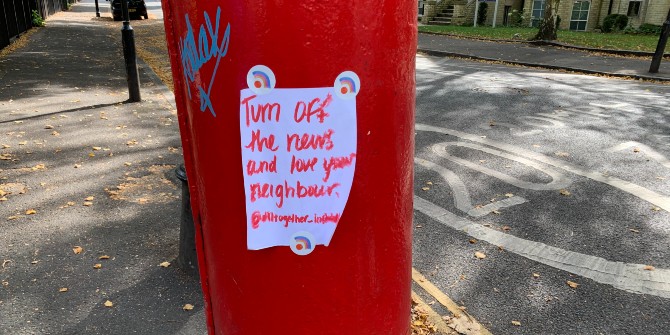While many behavioural scientists have questioned whether ‘behavioural fatigue’ exists, it is reasonable to suppose that people will eventually find strict lockdown measures difficult to follow, writes Adam Oliver (LSE). We cannot yet know which countries adopted the most effective response to the pandemic. And it is important that behavioural science is not confused with herd immunity – which is a public health concept.
Given that a core feature of the relatively new sub-field of behavioural public policy is the notion that reputation matters, it is perhaps ironic that, in many quarters, the use of behavioural science to inform public policy has taken something of a reputational hit during the UK’s response to the coronavirus pandemic. It is also ironic that the cause of much of this consternation did not emanate originally from behavioural science or behavioural scientists, and there is further irony still in that at least some of the cause of the consternation should not (I think) really have caused much consternation at all.

All of the above requires a little elaboration. David Halpern, the Chief Executive of the Behavioural Insights Team, is a member of the government’s Scientific Advisory Group for Emergencies – SAGE (he is also a member of the Independent Scientific Pandemic Group on Behaviours, or SPI-B, an indication that the government tends to concentrate its official advisory duties among a few select individuals). For many, Halpern is the ‘face’ of ‘behavioural science in policy’ in the UK. In the middle of March, Halpern gave a media interview in which he attempted to explain the logic of attempting to create ‘herd immunity’ to the coronavirus threat (Halpern was not the only person in the middle of March offering such explanations – Sir Patrick Vallance, the Chief Scientific Advisor and the Chair of SAGE, did the same).
The logic of herd immunity – an old public health concept – is that if a sufficient proportion of the population become infected with a virus, and consequently gain immunity from that virus, then the virus cannot easily transmit, and in essence the whole of the population is protected. It is a concept that is often discussed in relation to vaccinations for children – for example, if, say, 90% of the children within a country receive the mumps, measles and rubella (MMR) vaccine, then all children are effectively covered. There are unfortunately, however, a number of key differences between coronavirus and established vaccines that render the concept of herd immunity more problematic with the former. Firstly, and most importantly, although there may occasionally be serious side effects, vaccines tend to be safe. A very small percentage of people suffer serious side effects, or die, from a vaccine (ensuring that is so is a principal reason they generally take so long to develop); the same cannot be said of the current coronavirus. Also, we now know that it would have taken a very long time to achieve herd immunity. Indeed, given that we are not even sure of the extent to which having had the virus offers immunity, herd immunity might never have arrived at all. Further pursuing complete herd immunity would have likely made the already catastrophic number of deaths seem modest by comparison.
The government, principally via the voice of the Secretary of State for Health Matt Hancock, claims that pursuing herd immunity was never part of its policy. With respect to complete herd immunity, that might be right, but attempting to build up some immunity via infection within the population, so as to ‘flatten the curve’ and mitigate the possibility for future waves of the virus (with the intention of preventing huge surges in demand for health care services, given that nearly everyone expected a vaccine to be a fairly distant prospect), was clearly a reason for delaying the lockdown. Moreover, at the time that those decisions were taken, when it could reasonably be expected that having had the infection would guarantee immunity (and we might still expect now that it may indeed give many people immunity, at least for an extended time period), it was not an irresponsible strategy to pursue. Indeed, Sweden, with its constitutionally-constrained expert (i.e. epidemiologist) led response has taken a softer approach than most countries, partly also based upon the intention of building up some immunity in the population, a considered approach that is a world away from the ‘denial’-based (lack of) strategies in, for example, Brazil and Belorussia.
Over the long term, when the dust has settled on all of the mortality, morbidity, financial and values-related implications of this pandemic, it is not impossible that a delayed approach to lockdown, and/or a relatively soft approach to dealing with coronavirus, will prove to be the least harmful approach that could have been taken. It might, of course, prove to have been the most harmful approach to take; no one yet knows. But Halpern, in attempting to explain complete herd immunity (which we can now be sure would have been highly harmful), unwittingly associated this concept in the eyes of many with behavioural science, when it is not behavioural science at all.
The second early ‘behavioural-informed’ justification for the UK government’s response to the pandemic that has caused much consternation, particularly within the behavioural science community, was the suggestion that people, in lockdown, would suffer from ‘behavioural fatigue’. No one seems to be entirely sure from where the term behavioural fatigue originated, but the most likely candidate is not Halpern, but the Chief Medical Officer for England, Chris Whitty. Whitty, a doctor, apparently associated this notion with his observations that patients often fail to adhere to their medications, assuming, in the broad sense of their term, that they ‘tire’ of doing so. This consolidated the government’s view that in order to protect the health care service, a hard lockdown ought to be introduced at the optimum moment; it would be possible to lock people down for only so long, and therefore to ensure that the worst of the virus was over before the lockdown was ended, it was important not to lock down too soon.
Hundreds of behavioural scientists objected to the notion of behavioural fatigue (including many members of the government’s own advisory committees), and wrote an open letter stating that there was no evidence for this concept, and that it thus should not be used as a justification for the delay in a hard lockdown. However, to me, to consider something that might be labelled behavioural fatigue was not misplaced. It is notoriously difficult for people to sustain changes to their personal lifestyle choices, even when they expressly state that they want to change them, for example, in relation to diet, exercise and smoking. Hard lockdowns are almost the ultimate in infracting upon personal lifestyle choices, and even if most people initially and for a time support those infractions, it does not seem unreasonable to me to expect that they will eventually react against them.
There may, of course, be many different reasons why people, in a broad sense of the term, ‘tire’ of a lockdown. For example, there may be genuine physical and mental tiredness of continuing with an unfamiliar routine (or being deprived of a familiar one), there may be boredom of doing nothing, a concern with finances, and loneliness caused by the enforced distancing from friends and some family members, or abuse caused by an enforced lack of distancing from others, and a host of other reasons the mitigation of which perhaps call for their own tailored policy responses. But as a general ‘catch-all’ for the likely reactance to the malaise of being locked down for too long, perhaps caused by basic human instincts for free association, and thus as a justification for reasoning that lockdowns have a highly finite life, ‘behavioural fatigue’ seems to me as good a term as any. By the beginning of May we were seeing the beginnings of such reactance already in many countries, and thus it makes sense to try to introduce lockdowns at the optimum moment in order to best realise their benefits. The UK government might still have locked down too late (again, no one really yet knows), but there was a logic to the delay.
As noted at the beginning of this post, behavioural scientists have received a lot of misplaced criticism in relation to the UK’s response to the coronavirus pandemic. Behavioural scientists have much to offer, not least in relation to offering advice on how best to introduce interventions that may limit the harms that this sudden and unforeseen event has imposed upon the whole world – a point on which I will elaborate elsewhere.
This post represents the views of the author and not those of the COVID-19 blog, nor LSE.





“behavioural scientists have received a lot of misplaced criticism in relation to the UK’s response to the coronavirus pandemic.”
You ain’t seen nothing yet. Epidemiologists especially, and Behavioural scientists have been co-authors of an unprecedented experiment that has caused hardship to millions. The claim that it has/will save lives is about to be put to the test in the coming months and years. Already we see thousands of deaths as a result of the messaging, “Stay in Doors”, and a reluctance of parents to send their children to school, even though the risks are “staggeringly low”.
At least in Sweden they treated their population like adults, and that population now shares the responsibility. Here, the responsibly will lie with the “scientist”, as we handed all the responsibility over to them. Trumps dabbling in chloroquine may come to be seen as positively benign, in comparison to the side effects of state sponsored lockdown.
Misplaced or not there will be a lot of criticism to go around.